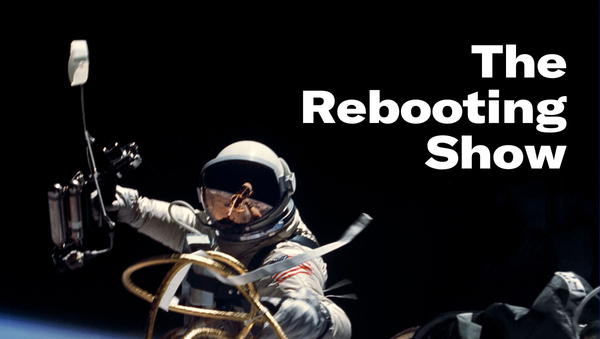The Slowdown's less frenetic approach to media
"We didn't see in the world a company that was truly looking at this vector of culture, nature and the future"
Subscribe on Apple Podcasts and Spotify
What a strange end to the year, with Omicron the march, inflation jitters and more unknowns than seemingly ever before. But there’s not the same amount of panic and anxiety as the spring 2020 — positive Covid tests seem to be the new social media flex. Nearly two years into this pandemic era, we’ve grown resilient, whether we dwell on it or not. We have so many more tools and knowledge now than when this all started, and we are also just better equipped ourselves to deal with the ups and downs and uncertainties.
The last two episodes of The Rebooting Show this year are tied to this theme, considering what we have figured out since the pandemic began. This week, I spoke to Spencer Bailey and Andrew Zuckerman, co-founders of The Slowdown, a media company focused on making sense of the world around us. When the pandemic hit, they started At a Distance, a podcast in which they shared conversations with an array of influential people about how we should rethink the world. The resulting interviews became fodder for a new book. Thanks to Mediaocean, sponsor of these year-end episodes.

Covid was momentous from the start, even if we just called it by the generic coronavirus. Once cities started shutting down, it was clear this wasn’t a passing blip or even a localized shock. It wasn’t 9/11 or the Financial Crisis. The scale was unimaginable. The entire world on pause. For those lucky enough to be forced to isolate — health care and essential workers didn’t have this luxury — the pandemic was a forced period of reflection. Many didn’t like what they saw.
For The Slowdown, just a year old as a company, its bet that the frenetic pace of the world was unsustainable turned out to be on the nose. Without being able to host its intimate conversations for Time Sensitive, The Slowdown’s conversation series with influential figures in business, arts and culture, Spencer and Andrew decided to move to Zoom with a new podcast, At a Distance, a podcast that gathered luminaries to use the forced isolation we all dealt with in order to think big thoughts about what comes next. At a Distance has compiled over 130 interviews so far.
“We realized everyone we were talking to was thinking in a really different way,” Andrew said. “Everyone had permission to think big picture, like this rupture had occurred and everyone was thinking about the world in a very different way and seeing opportunities and the issues were super coherent.”
Finding an intersection
My theory of media businesses is those from the creator or content side typically start with the need to make something they want into the world, then they fit it to the market opportunity and business model. People coming from the business side tend to work in reverse. Both can work. The Slowdown is the first type. “We wanted to make something that we wanted in the world that we couldn't get,” said Andrew. “So we figured we'd make it ourselves.”
“Our philosophical foundation was not in terms of scale, growth and the attention economy. We didn't see in the world a company that was truly looking at this vector of culture, nature and the future and where that comes together.”
A time capsule
From its start, the pandemic and the unprecedented society-wide mobilization to fight it would be a giant experiment. The most optimistic believed it would turn out to be short-lived, but those hopes were dashed early on, although only the most dour would believe we’d be looking at a fifth wave this winter. Andrew and Spencer saw this would be an “urgent” moment. It turned out to be something of a time capsule as the pandemic kept going and going and going.
“One of the things about this project that I've been thinking a lot about lately is how uncomfortable it made us throughout and a lot of ways, because it was so urgent,” Spencer said. “We felt this urgency to just keep making these episodes.”
A new type of luxury
This is a strange time for luxury brands. On the one hand, the rich are getting richer, so that’s good for business. On the other hand, the growing inequality divide and focus on climate change pose existential challenges. Both Spencer and Andrew see an opportunity to redefine luxury media to be less about worshipping products and more around storytelling that focuses on how to leave a thoughtful and meaningful life.
“A lot of the fashion people actually that we've spoken with, they do sit in luxury, but they care a lot about the environment,” said Spencer. “These are people who are thinking a lot about the future of the planet through the lens of what they do and what they're doing. They all admit it's rarefied, but there is a ripple effect.”
Resilience and optimism
We focus rightly on the many failures of the pandemic, particularly those of our public institutions but also as society has frayed and retreated to various tribal identities, often tied to political persuasions. And with 5 million dead from the pandemic – the actual count is much higher – there’s no putting a happy front all the premature loss. And yet, through all of that, society has not completely fractured. In At a Distance, designer Stefan Sagemeister points to data showing we are still living longer, suffer less food insecurity and have increased freedom.
“In the face of all of this stuff, we are seeing a world that does have a lot of signs pointing to greater democracy, greater freedom,” said Spencer. “And I think there's a lot of cases to be made against that, but I do think Stefan makes some really strong arguments and it leaves me perhaps not hopeful, but definitely rationally optimistic about our future.”


Many of you are gearing up to head to Las Vegas again. Yes, it’s time to head to CES, where the worlds of media, advertising and tech collide. Anyone who has been to CES knows that it can be chaotic. Mediaocean is here to help. They’ve set up The Mediaocean Retreat at the Cosmopolitan of Las Vegas from Wed. Jan. 5th through Fri. the 7th. They’re transforming a 3rd-floor ballroom for keynotes and panels as well as meeting and co-working space. Guest speakers include Rishad Tobaccowala (next week’s guest on The Rebooting Show), S4 Capital CEO Martin Sorrell, Melissa Grady, CMO at Cadillac, Sarah Personette, chief customer officer at Twitter, and many other brand, agency, and media execs.

5 Things to check out
The coming subscription reality check in 2022 will likely be a continuation of the comedown seen in 2021. My former colleague Jack Marshall notes in Toolkits that the early gains for publishers piling up big subscriber numbers with much help from sweetheart introductory offers will spend 2022 continuing their quest to prove value to their new customers. Getting people to pay is only step 1.
Trump was a helluva drug for news publishers. Every publisher focused on politics in any way, shape or form benefited greatly from Trump’s histrionics, drama and the emotions stirred by those. It’s no surprise that the Washington Post is struggling to maintain the momentum of the Trump era. The Wall Street Journal reports that traffic to the Post is down 28% from last year. More alarming is the data point that its progress in piling on digital subscriptions has entered a churn spiral, with total subscriptions falling from 3 million to 2.7 million. Also ominous: 86% of subscribers are over 55. Yikes.
The New York Times sure looks ready to scoop up The Athletic. Puck has followed up on the FOS report from last week that talks between the Times and The Athletic are gaining steam. The addition of The Athletic’s 1.2 million subscribers to the Times 7.6 million would put the company close to its 10 million goal. The Times is well positioned to add complementary publications like The Athletic that have subscription models.
The end of the year is a good time to remind yourself where Big Tech’s many antitrust battles stand. Like crypto, this is a long game, so there’s always time to catch up. SparrowOne has a good rundown of the many governments attempting to rein in tech platforms in the name of privacy and competition. Many times Americans are confused by the more activist approach taken by other governments, although the U.S. has typically been a backwater of energetic use of policy to ensure fair markets. Innovation in this area won’t come from Washington.
Vertical publications tend to be hard for large consumer media to pull off. The latest example of this is The Wall Street Journal pulling the plug on The Experience Report as a standalone publication after less than two years. The “digital offering” was to pull together coverage on “the ways that companies optimize data, technology and design to drive successful interactions with their customers and employees.” The vertical was created as part of a deal with SAP. The problem with these single-sponsor spinoffs is contracts end, and sometimes people don’t sign up again. As my mom told me, don’t put all your eggs in one basket. The Experience Report’s small but mighty team will move their coverage over to WSJ’s CMO Today.

Thanks for reading this week. Please send any feedback by hitting reply or email directly: bmorrissey@gmail.com.




